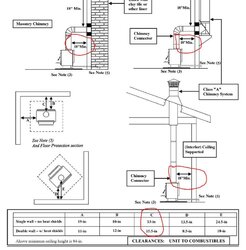My turn for a question. This one kept me up last night. I noted in another thread that a stove manual has a stove clearance that put the single-wall connector clearances under 18". I did some digging through stove manuals for stoves that have close clearances and a flue exit towards the rear of the stove. I found another example in the Quadrafire manuals. In the 3100 manual there is a single-wall pipe clearance of 12" for the steptop and 15.5" for the flat top. ???
So this begs the question of tested single-wall NFPA211 clearances vs the stove tested clearances. I haven't recently tested single-wall pipe at 12" from a wall with a 900°F degree flue, but I'm fairly certain that it will take the wall directly behind it to an excess of over 200°F if the pipe stays hot for an extended period of time. Now I know this is not recommended operation, but the design of the system is to be safe in spite of user foolishness. It seems to me that a stove manual (regardless of company) should have a footnote by clearances that are under the code clearances for the pipe that says *will require approved shielding of pipe to achieve these clearances.
This is the kind of thing that would have old Elky calling his legislators. Am I being pedantic, missing something, or are the stove mfgs. being coy here?
So this begs the question of tested single-wall NFPA211 clearances vs the stove tested clearances. I haven't recently tested single-wall pipe at 12" from a wall with a 900°F degree flue, but I'm fairly certain that it will take the wall directly behind it to an excess of over 200°F if the pipe stays hot for an extended period of time. Now I know this is not recommended operation, but the design of the system is to be safe in spite of user foolishness. It seems to me that a stove manual (regardless of company) should have a footnote by clearances that are under the code clearances for the pipe that says *will require approved shielding of pipe to achieve these clearances.
This is the kind of thing that would have old Elky calling his legislators. Am I being pedantic, missing something, or are the stove mfgs. being coy here?



 .
.